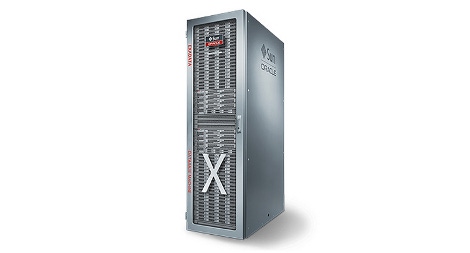Intel Designs Custom Scalable Chips for Oracle’s Massive Database MachinesIntel Designs Custom Scalable Chips for Oracle’s Massive Database Machines
Processors in latest Exadata feature elastic frequency, core-count

Intel has designed a custom processor for Oracle it says will enable the customer to dynamically scale frequency and the number of cores processing Oracle software workloads.
Customizing chip designs for high-volume customers is already a big business for Intel, and one that is growing. The company makes custom chips for vendors as well as web-scale data center operators, such as Facebook, Google and Amazon.
In June, Intel also announced a hybrid processor that combines its Xeon E5 chip with a Field-Programmable Gate Array. It has not disclosed an availability date, but once out, customers will be able to change the processor’s configuration dynamically as their needs change.
The custom SKU Intel came up with for Oracle is a modified version of its latest Xeon E7 v2 chips. Making frequency and the amount of active cores dynamic takes compute power elasticity to new level of granularity. Elastic capacity traditionally means dynamic adjustment of the amount of physical or virtual machines allocated to a certain workload.
The companies made the announcement at the same time Oracle announced the latest model of its massive database machine called Exadata. The machine, X4-8, uses the custom 15-core chips Intel designed to power its powerful database server hardware.
Diane Bryant, senior vice president and general manager of the Data Center Group at Intel, said, “This customized version of the Intel Xeon processor E7 v2, developed in collaboration with Oracle, helps maximize the power of the Exadata Database Machine X4-8 by elastically accelerating peak performance of database operations, while also reducing the data footprint.”
Oracle says it has optimized X4-8 specifically for Database-as-a-Service and in-memory database workloads. It comes with up to 12 terabytes of DRAM and can be used to either consolidate hundreds of databases or to run massive databases in-memory.
The system has eight-socket severs, intelligent storage, fast PCI flash cards and InfiniBand connectivity.
Here are the hardware enhancements over the previous generation of Exadata:
50 percent more database compute cores, using the Xeon E7 v2 15-core processors
Up to 6TB of memory per compute node for a total of 12TB per rack
2x faster InfiniBand with a new PCIe card with all ports active
Nearly two times more local disk space
Up to 672 TB of disk storage and 44 TB of PCI flash per rack
Oracle also recently announced new software that enables customers to use SQL to run queries across SQL, Hadoop and NoSQL databases.
About the Author
You May Also Like







